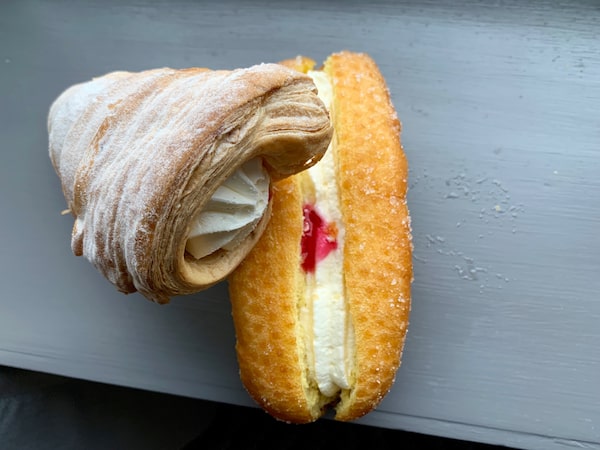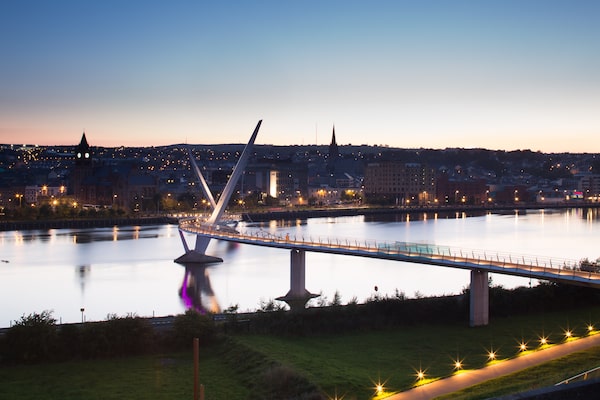
The Derry Girls mural in Derry's city centre has become a go-to spot for visitors.Tourism Northern Ireland/The Globe and Mail
There’s a mural drawing people to the Walled City of Derry in Northern Ireland. It’s not the one that famously declares, “You are now entering Free Derry,” or any of the other civil rights ones in the Bogside neighbourhood outside the walls. This one is on the side of Badgers Bar in the city centre and shows four sassy teen girls, and one puzzled “wee English fella,” in Catholic school uniforms proudly wearing rainbow pins and flashing a peace sign.
Erin, Orla, Michelle, Clare and James are the stars of Derry Girls, the British black comedy that burst onto the scene in 2018, went international thanks to Netflix, and was renewed for a third season earlier this year. It’s an unabashedly female, coming-of-age sitcom set in beleaguered, working-class Derry during the Troubles of the early 1990s, a devastating time when unionists/loyalists (mostly Protestants) who wanted to stay in the United Kingdom clashed with nationalists/republicans (mostly Catholics) who wanted to leave and form a united Ireland.
I first heard of Derry on U2’s 1983 album War with the song “Sunday Bloody Sunday.” Bloody Sunday happened here in 1972, when British soldiers killed 14 civilians during a peaceful civil rights march in the Bogside. In 2010, the British prime minister apologized, calling that day “unjustified and unjustifiable.” This year, a former paratrooper, known as Soldier F, was ordered to face murder charges. Sadly, violence hit the city again in April: Investigative journalist Lyra McKee was shot dead while standing by a police vehicle during a night of rioting in the Creggan area. The New IRA, a dissident republican group, admitted responsibility and apologized to McKee’s family, but the gunman has not been arrested. McKee was honoured with a peace rally and three-day walk from Derry to Belfast.

The success of Derry Girls has brought positive headlines to the city.Tourism Northern Ireland/The Globe and Mail
The success of Derry Girls means that the city is also earning positive headlines, however. Created and written by Derry-born Lisa McGee, the show is such a smash hit that it’s attracting a new wave of visitors to a city that usually gets short shrift from those who stop for a tour of the walls before road tripping down the Causeway Coastal Route to Giant’s Causeway and the Carrick-A-Rede rope bridge. Now people are clamouring to eat cream horns, see the church where a Virgin Mary statue “wept” what turned out to dog urine leaking through the ceiling and order fish and chips from the chippy that caused mild-mannered James to shout “It’s much, much too greasy – even the smell of it makes me feel physically sick.”
We’re out of luck on the chippy front – that scene was filmed at John Long’s Fish & Chips in Belfast – but Gleann Doherty of Derry Guided Tours sends me to Don’s Takeaway. Doherty has been giving historical walking tours here for six years and recently added one with a Derry Girls spin at the urging of his wise wife.
“Derry’s the only walled city in Britain and Ireland where you can walk a full circuit without stepping off the wall,” Doherty boasts, before taking me just outside the walls to pretty St. Columba’s Church, whose exterior and grounds were used for the scene when the fab five chase a supposedly dead dog to a church and concoct a miracle involving the Virgin Mary to miss an exam.

Butcher Gate is one of the entrances to the walled part of Derry.Tourism Northern Ireland/The Globe and Mail
Also outside the walls in Bogside, Doherty and I check out Dennis’s Wee Shop, which is closed because of construction but is the shop where Clare tries to solicit her friends’ money to sponsor an Ethiopian boy named Kamal, and everyone gets confused and thinks he lives in nearby Donegal.
I’m desperate to eat a cream horn, a horn-shaped pastry that isn’t unique to Derry, because of the scene where the family grills Granda Joe after hearing gossip that he was headed up a street he doesn’t usually go on with a pastry he doesn’t usually eat. “The cream horn wasn’t actually in the episode,” Doherty explains, “but it was talked about. The thing is, he doesn’t actually buy a cream horn – he buys a cream finger and says that under his breath.” I try both pastries at Doherty’s Home Bakery. Like Granda Joe’s secret girlfriend, I prefer fingers, éclair-shaped doughnuts with a dollop of jam.

A cream horn, left, and cream finger, right, from Doherty's Home Bakery.Tourism Northern Ireland/The Globe and Mail
Doherty’s tour is laced with asides about spotting the show being filmed, and wraps up at the Derry Girls mural near Foyleside Shopping Centre. As fans eagerly snap shots and uniformed school girls wander blithely by, we take time to appreciate the rainbow pins the girls wear in the mural because one of them comes out at the end of season one.
“The fabulous, feral Derry Girls are the new emblems of Northern Ireland,” the Guardian has written, and the declaration feels true as the country that people feared during the Troubles comes into its own with screen tourism from Derry Girls and Game of Thrones.
I join Sorcha Bonner on a Martin McCrossan City Walking Tour through the city of 110,000. The 400-year-old walls stand up to eight-metres high and enclose the city centre (not the entire city). Walking the complete 1.5-kilometre circuit on an elevated promenade takes you by seven gates, 22 cannons, churches, museums, murals and the landmark Guildhall Square. “Locals used to describe the city walls as a noose,” Bonner says, “but now we call the walls a necklace because they go all the way around.”
Originally named Doire for the old Irish word for oak grove, and later anglicized to Derry then rechristened Londonderry, the city with multiple names that straddles the River Foyle is tactfully referred to as Derry-Londonderry, but most locals say Derry.

The Bogside neighbourhood in Derry is home to Free Derry Corner and an array of civil rights and political murals.Tourism Northern Ireland/The Globe and Mail
I delve into Derry’s turbulent history at the Museum of Free Derry, which connects me with John McKinney of Free Derry Tours. We take a private walking tour of the Bogside’s famous political murals known as the People’s Gallery. McKinney’s brother, William, was killed on Bloody Sunday – as was Doherty’s father, Patrick – and those raw wounds add a poignant dimension to both tours.
McKinney takes me to Free Derry Corner, an iconic wall in the middle of a busy street that bears the slogan, “You are now entering Free Derry.” First painted in 1969 as a civil rights-era demand for change, the wall is currently white with black writing but occasionally gets repainted in solidarity with other causes.

The Peace Bridge, a pedestrian and cyclist link in Derry, has helped unite the two sides.Tourism Northern Ireland/Tourism Northern Ireland
My explorations take me past the ornate Guildhall to Derry’s newest landmark, the Peace Bridge, an S-shaped pedestrian and cyclist bridge that went up eight years ago and has helped ease tensions between the mainly Protestant and mainly Catholic sides of the River Foyle.
I power walk over the bridge twice with Lorcan McBride, whose adventure activity company, Far and Wild in St. Columb’s Park, takes people hiking, biking, longboarding, stand-up paddleboarding and kayaking. “The idea is to see the city from a different perspective,” he says after a Hawaiian longboard lesson on a drizzly day turns into a brisk hike to Pyke `N’ Pommes for fish tacos and then to the Walled City Brewery for Punt Purse and Craic Killer (fun killer) beer inspired, of course, by Derry Girls.

Walled City Brewery has Derry Girls-themed beer on tap — Punt Purse and Craic Killer.Tourism Northern Ireland/The Globe and Mail
Jennifer Bain was hosted by Tourism NI and Tourism Ireland, neither of which reviewed or approved this story.
Get there
I rented a car in Belfast for the 110-kilometre drive to Derry, and then looped back along the famous Causeway Coastal Route. The train is another option.
Stay
The Maldron Hotel Derry is inside the historic walls.
Eat
The Wig & Gown Champagne Bar and Restaurant in the Bishop’s Gate Hotel for lamb. Primrose for tea and scones. Peadar O’Donnell’s for a pint.
Live your best. We have a daily Life & Arts newsletter, providing you with our latest stories on health, travel, food and culture. Sign up today.